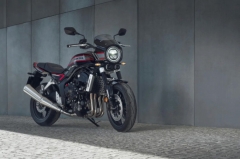Yamaha is developing advanced anti-dive suspension technology
Recent patents suggest that this tech will make its way into Yamaha’s performance-oriented machines.

Rapid fork sinking, or brake dive, happens during sharp, sudden braking typical of circuit riding but is also crucial for emergency stops on the road. This phenomenon, where the front forks compress and the rear end lifts, affects nearly all motorcycles on the market, impacting both performance and safety.
Meanwhile, under heavy acceleration, the rear suspension flattens out, causing the front end to lift and triggering the anti-lock system to intervene and prevent wheelies, which in turn limits acceleration. This phenomenon, known as squat, affects not just racing bikes but also those used by everyday riders.
Recognizing these challenges, Yamaha has filed a new patent aimed at addressing these issues to enhance safety and performance on both the road and the track. This innovative technology promises to deliver a smoother, more controlled riding experience, benefitting all riders from professional racers to casual enthusiasts.

Yamaha's new technology leverages cutting-edge electronic suspension management combined with insights and experience gained from their MotoGP efforts. This advanced system is expected to make its debut on popular models such as the Yamaha R1, MT-09, and R6. By intelligently distributing braking force between the front and rear wheels, the system enhances stability and control during both deceleration and hard braking scenarios.
Additionally, the system manages the bike’s brakes and adjusts suspension spring preload in real time, ensuring optimal performance and comfort. This integration of advanced features aims to provide riders with a smoother, safer, and more responsive riding experience, whether they are navigating city streets or pushing the limits on a racetrack.
This development represents a significant evolution of electronic suspension systems, making them more advanced by incorporating sophisticated brake management. By seamlessly integrating these functions, the system offers a higher level of control and performance than previous tech.

Although the exact timeline for implementation on consumer bikes remains unknown, the recent patent filing indicates that this innovative system could be available soon. The fact that it is already influenced by and potentially used in MotoGP suggests that its debut on consumer models may not be far off. This means that riders could soon benefit from MotoGP-level technology in their everyday rides, enhancing both safety and performance.
Tagged Under
Related Articles
-
Maxed out: Yamaha NMax 125 Tech Max takes home Design Win / News
Yamaha has once again brought home a win at the Red Dot Awards, this time for the NMax 125 Tech Max. This makes it the 14th year in a row the brand has earned a design award.
-
New Yamaha NMAX ‘Turbo’ debuts in Indonesia / News
Yamaha Indonesia has unveiled the NMAX ‘Turbo’ marking the next generation of the popular maxi-scooter.
-
CFMOTO unveiled an all-new 675cc three-cylinder engine at EICMA 2023 / News
At EICMA 2023, CFMOTO surprised the world with an all-new 675cc three-cylinder engine.
-
Yamaha unveils 2024 MT-09 with performance-oriented updates / News
Yamaha has pulled the covers off the 2024 MT-09 featuring updated styling and improved underpinnings.
-
Feast your eyes on the 2024 Yamaha XSR900 GP / News
Yamaha has unveiled the 2024 XSR900 GP in the global market with a focus on its rich racing heritage and cutting-edge performance.
Latest News
-
Take a look at the new Honda CB1000F / News
Honda has revealed the production-spec CB1000F, blending retro style with Hornet-based performance and modern tech. Expected to hit UK showrooms in early 2026.
-
Ducati launches all-new Hypermotard V2 with cutting-edge tech / News
The Hypermotard V2 keeps its aggressive stance and signature beak while bringing sharper design and modern electronics.
-
2026 Kawasaki Z650 S gets more aggressive styling and premium tech / News
The 2026 Kawasaki Z650 S adds new styling, updated tech, and the same dependable 649cc engine loved by middleweight riders worldwide.









